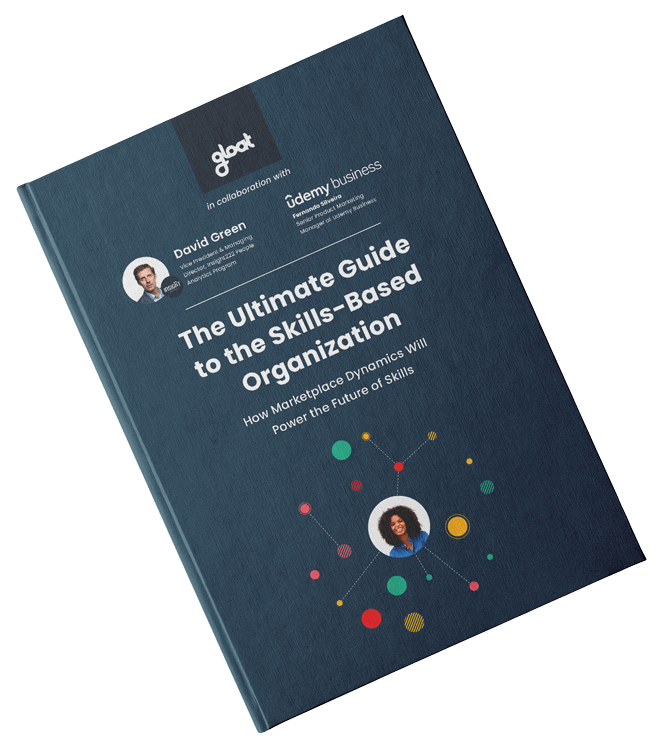Top reasons why companies become skills-based organizations
Find out why Novartis, HSBC, and Mastercard are prioritizing skills transformations Skills-based strategies have been in the spotlight for quite some time now. The World Economic Forum predicted that by 2025, 50% of the global workforce would need to build new skills, further motivating leaders to move skills to the top of their agendas. Rather

Find out why Novartis, HSBC, and Mastercard are prioritizing skills transformations
Skills-based strategies have been in the spotlight for quite some time now. The World Economic Forum predicted that by 2025, 50% of the global workforce would need to build new skills, further motivating leaders to move skills to the top of their agendas.
Rather than fading into the background, the skills-based strategy trend is still going strong. In fact, now that a few years have passed since this way of working became popularized, we’re starting to get anecdotal stories from executives who’ve spearheaded these initiatives that shed light on the kinds of game-changing benefits they’re seeing.
So, if you’ve ever had any doubts about whether or not launching a skills strategy is actually worth it, let these leaders from Novartis, HSBC, Mastercard, Standard Chartered Bank, and MetLife break down how and why their initiatives are paying off.
Inside the shift to skills-based strategies
By now, many leaders know it’s in their best interest to adopt skills-based strategies. According to recent research from Deloitte, skills-based organizations are 107% more likely to place talent effectively, 52% more likely to innovate, and 98% more likely to retain high performers. Consequently, it’s easy to understand why 98% of organizations are eager to shift towards skills-based ways of working.
Yet, despite this growing enthusiasm for skills strategies, only one in five companies are adopting these approaches at an enterprise scale. Many organizations lack the data and insights needed to gain an in-depth understanding of the capabilities their workforces have and the skills they will need to build next. Without this information, leaders won’t be able to redeploy and reallocate talent based on emerging skill needs, in turn making it virtually impossible for their companies to become skills-based organizations.
Fortunately, a new generation of AI-powered skills intelligence tools and talent marketplaces have the potential to turn skills-based visions into realities. Skills intelligence tools equip executives with a bird’s eye view of their workforce’s capabilities, while talent marketplaces enable leaders to redeploy employees to open opportunities based on the skills they have and the knowledge they wish to hone.
5 reasons why top-performing companies are becoming skills-based organizations
While most companies are still at the start of their skills journeys, there are a handful of visionary organizations that are already harnessing skills intelligence tools and talent marketplaces to put skills at the center of every initiative. Reflecting on the success of their transformations, these forward-thinking leaders cite a few reasons why shifting to a skills-based approach is so advantageous, including:
#1. To level up productivity
As economic turbulence continues and the pressure to do more with less mounts, many leaders are looking for ways to help their workforce perform more efficiently. When it comes to driving productivity, skills-based strategies can be a complete game-changer, as Standard Chartered Bank’s Chief Strategy and Talent Officer Tanuj Kapilashrami has experienced firsthand.
In describing her organization’s skills transformation, she explains, “This idea of talent flowing to skills is to me at the heart of what becoming a skills-powered organization is all about. And it has to happen. If it doesn’t, there’s a huge amount of wasted productivity in companies because people are boxed into an idea of job descriptions without us really realizing what skills they have.”
#2. To tap into peoples’ hidden capabilities
Every employee is capable of so much more than what they were hired to do. However, when companies rely on traditional, job-centric ways of working, leaders rarely get a chance to tap into all of the skills that their people are bringing to the table.
In contrast, employees can put all of their knowledge and expertise to use at a skills-based organization by pitching in on projects and gigs with different teams. Mastercard’s Chief People Officer Michael Fraccaro believes that shifting to a skills-based approach has enabled leaders at his organization to discover talent that hadn’t been on their radars. Referencing their skills strategy, he says, “This was about connecting people to these priceless career opportunities. And we said, ‘Wow, we’ve just been able to find talent with particular skills in parts of the organization that we didn’t even consider before.’”
#3. To understand which reskilling and upskilling initiatives to prioritize next
Skills-based organizations don’t just gain insight into all the capabilities within their workforce. They’re also able to identify emerging knowledge gaps before they snowball into larger problems so that employees can be upskilled and reskilled accordingly.
In describing Novartis’s skills transformation, Global Head of Performance and Talent Development Sara Steiner explains how a talent marketplace has enabled her organization to rapidly deploy talent and identify where skill-building efforts are most needed. “We look at skills to jobs, skills to people, and skills to growth, using the talent marketplace to really understand what are the skills that we link to people,” she says. “And we often talk about how we are able with the deployment of the talent marketplace to really quickly understand our organization much better than we did in the past. What are the skills that we have in our organization? It might not be perfect, but it’s so much better than anything we had before.”
#4. To reallocate talent to high-priority areas of the business
As consumer demands evolve and the proliferation of AI promises to shift job and skill needs, every company must be able to swiftly redeploy talent to high-priority areas of the business. However, without insight into transferable skills, leaders will struggle to identify which employees have the background needed to excel in roles that are becoming more popular.
Laura Powell, Global Head of HR, recounts her experience with this exact challenge when HSBC was looking for more wealth managers. Rather than hiring externally, the leading financial services institution created a new reskilling program to help employees move into these higher-priority roles. In describing the success of this initiative, she notes, “We took this leap of faith that transferable skills can really work in order to train people up to do these key roles for us in the future. And we’ve had over a 90% success rate which is amazing.”
#5. To strengthen partnerships with other areas of the business
While HR may be at the helm of these transformations, shifting to a skills-based approach requires collaboration from stakeholders across the organization. By bringing leaders from various departments together to collaborate on skill-building, executives can strengthen their partnerships with colleagues in various departments.
While discussing how MetLife launched its skills-based transformation, Chief Employee Experience and Care Officer Brendan Lynch notes, “What I love about what we’re doing [with our skills initiative] is that we’re doing this in co-creation. So it’s no longer HR go off and create something and then bring it forward. It’s actually co-creation. So it feels and operates very differently at the present time.”
To learn more about the shift to putting workforce capabilities at the center of every initiative, check out our guide to becoming the ultimate skills-based organization.





